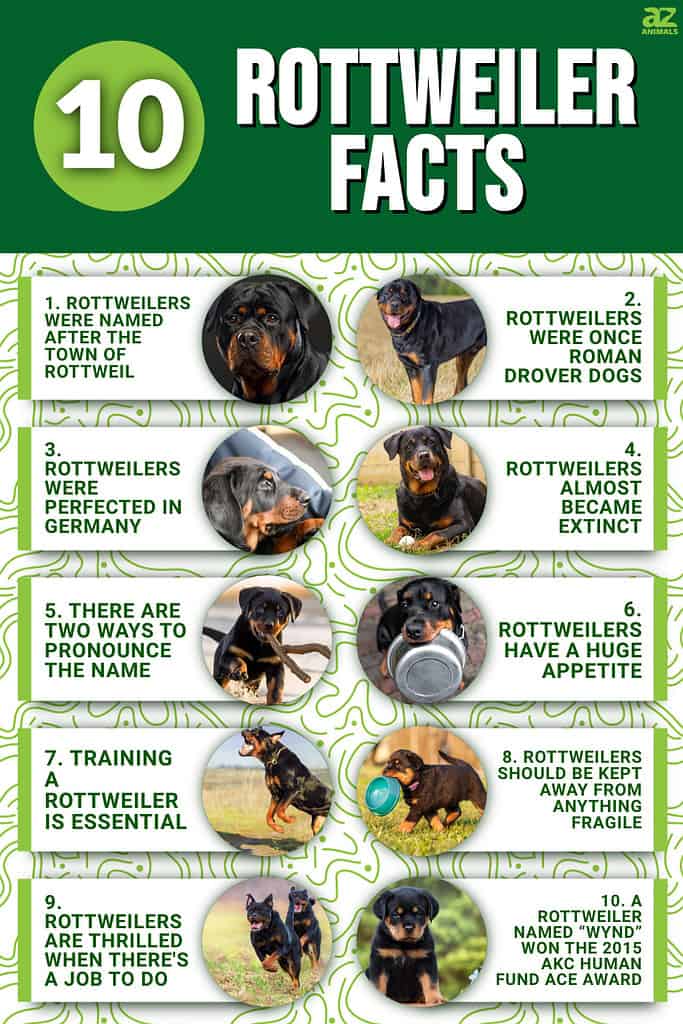
The Rottweiler is among the top ten most popular dog breeds, according to the American Kennel Club (AKC). Rotties, as they are fondly called, have a playful demeanor and a remarkable sense of confidence, wit, and devotion to their masters when adequately reared. Depending on their training, the behaviors of these canines differ from one another. While some are calm, well-behaved house dogs, others are excellent performers.
The build of a Rottweiler denotes exceptional power and agility, as well as a brave, vigilant, and noble disposition. They are intelligent, diligent animals that make excellent police dogs.
Now, here are ten incredible facts about them.
1. Rottweilers were named after the town of Rottweil

Around the year 73 or 74 AD, the troops of ancient Rome along with their herder dogs set up camp near the Neckar River in Germany.
©TrapezaStudio/Shutterstock.com
The ancient Roman troops and their herder dogs camped around the Neckar River in Germany in 73 or 74 AD, according to The Rottweiler Club of the United Kingdom. Large, tough dogs were utilized as herders and bear hunters throughout the Middle Ages. This region grew into a little town known as “das Rote Wil,” which later became Rottweil. These dogs gave rise to the Rottweiler breed, named after the city of Rottweil.
2. Rottweilers were once Roman drover dogs

Rottweilers were utilized as herding dogs and bear hunters in the middle ages.
©iStock.com/Ideas_Studio
Rottweilers are thought to be descended from old Rome’s drover dogs. These were Roman cattle hounds that traveled with the Roman legions and their herds across Switzerland and into Southern Germany.
Rottweilers were utilized as herding dogs and bear hunters in the middle ages. They could keep cattle from wandering and kept an eye on the flock at night.
3. Rottweilers were perfected in Germany

The Rotterman is the result of crossbreeding a Rottweiler and a
Doberman Pinscher
.
©Gregory Culley/Shutterstock.com
The Rottweiler’s progenitors were introduced to Germany by Roman legions on their way to conquering Europe. As there were no fridges then, the troops took their animals instead of slaughtering the cows for food before the expedition. They needed help keeping their cattle in line, of course. Because of their tenacity and strength, the Rottweiler’s predecessors were ideal canines for work. In addition to guarding and carrying supplies, the dogs were deployed along the journey.
The army eventually halted in the Wurtemberg region of Germany in around 73 AD. Villas with red-tiled roofs filled the settlements there. Das Rote Wil was the name given to the charming town because of the red tiles and wil, the Roman word for a villa. The town was later renamed Rottweil. As herding and guard dogs, Roman dogs thrived there. They subsequently crossed with other local canines to become the Rottweiler we know today.
4. Rottweilers almost became extinct

Rottweilers were first imported to the United States in 1910.
©nicolas.fontana/Shutterstock.com
Paved roads and railroads began to influence how livestock was transported to market in the mid-nineteenth century. While herding dogs were no longer required when carrying cattle, Rottweilers were laid off. Rottweiler numbers continued to fall, and clubs vanished. The breed was on the verge of extinction, but a small group of breeders fought valiantly to preserve it. The breed acquired a new use in the military in the twentieth century. Rottweilers were first imported to the United States in 1910, and their popularity multiplied. The Rottweiler is now the tenth most popular dog breed in America.
5. There are two ways to pronounce the name

Rottweilers are believed to have originated from the drover dogs of ancient Rome.
©Donamen/Shutterstock.com
Because the Rottweiler is a German breed, you should pronounce it rott-vile-er in German. Also, rott-why-ler is appropriate in the U.S.
6. Rottweilers have a huge appetite

While adult dog food may have been suitable before, pregnant Rottweilers typically need to eat puppy food until they stop nursing.
©otsphoto/Shutterstock.com
Rottweilers have a voracious appetite that is proportional to their size. Depending on how active it is and how old it is, a Rottweiler can eat anywhere from 5 to 10 pounds of dog food every week.
Due to their large body size, males are typically heavier eaters than females. Their eating should be closely monitored because they have a propensity to overeat, which can lead to considerable weight gain.
7. Training a Rottweiler is essential

Rottweilers are extremely powerful canines and must be trained on when to use their strength and when to restrain themselves.
©Olexandr Andreiko/Shutterstock.com
Every Rottweiler is unique, just like every person. These are extremely powerful canines, and they must be trained on when to use their strength and when to restrain themselves. Fortunately, because the dogs are bright and enthusiastic, training is relatively simple compared to that required for more reserved breeds. To guarantee a gentle pet, raising your dog early and consistently is critical.
8. Rottweilers should be kept away from anything fragile

Dog food is food specifically formulated and intended for consumption by dogs and other related canines.
©Rita_Kochmarjova/Shutterstock.com
Rottweilers have a history as herders, so it’s only natural that they’re strict with their owners. When they desire things, humans, and other animals to fall into place, they frequently run into them. Even though trained Rottweilers are kind, breeders do not recommend them for families with small children or the elderly.
9. Rottweilers are thrilled when there’s a job to do

Rottweilers can be service dogs, guide dogs, custom inspectors, drafting and hauling dogs.
©Callipso/Shutterstock.com
Rottweilers can be service dogs, guide dogs, custom inspectors, drafting and hauling dogs, and, of course, loving friends that love the company of others since they are intelligent, untiring, and ready to please. They are incredibly loyal and possess a strong protective drive, making them extremely defensive of their pack.
The Rottweiler requires regular physical and mental stimulation, such as long daily walks and runs, or rigorous activity in a safe environment. It prefers the cold and can become uncomfortable in the heat. It can survive in the open in moderate to cool temperatures as long as there is more than enough shelter. However, it must spend considerable time indoors with its human family to bond properly.
10. A Rottweiler named “Wynd” won the 2015 AKC Human Fund ACE Award

Rottweiler puppies should be walked 2-3 times a day, for 20 minutes each time.
©otsphoto/Shutterstock.com
Renice Zimmerman of Virginia owns a therapy dog named Wynd. This incredible Rottweiler has worked as a therapy dog for military families at TAPS (Tragedy Assistance Program for Survivors) and is a constant presence at the Hampton Veterans Hospital, where he helps veterans with PTSD and substance misuse. Wynd also volunteers with the BARKS reading program run by the Suffolk Humane Society. Wynd received the AKC Human Fund ACE Award for Therapy Dogs in 2015.
The photo featured at the top of this post is © Olexandr Andreiko/Shutterstock.com
Ready to discover the top 10 cutest dog breeds in the entire world?
How about the fastest dogs, the largest dogs and those that are -- quite frankly -- just the kindest dogs on the planet? Each day, AZ Animals sends out lists just like this to our thousands of email subscribers. And the best part? It's FREE. Join today by entering your email below.
Thank you for reading! Have some feedback for us? Contact the AZ Animals editorial team.






